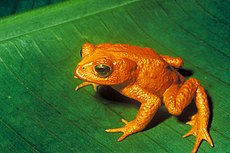List of domesticated animals: Difference between revisions
| Line 46: | Line 46: | ||
** [[Crocodile]] |
** [[Crocodile]] |
||
** [[Grass hopper; Patanga]] |
** [[Grass hopper; Patanga]] |
||
** [[Lizard]] |
|||
** [[Silkworm]] |
** [[Silkworm]] |
||
** [[Snail]] |
** [[Snail]] |
||
Revision as of 06:38, 23 May 2008
This article possibly contains original research. (September 2007) |
| Conservation status | |
|---|---|
 | |
| Extinct | |
| Threatened | |
| Lower Risk | |
Other categories | |
| (list) | |
Related topics | |
 Comparison of Red List classes above and NatureServe status below  | |
This is a list of animals that have been domesticated by humans. The list includes species or larger formal and informal zoological categories that include at least some domesticated individuals.
To be considered domesticated, a population of animals must have their behavior, life cycle, or physiology systemically altered as a result of being under human control for many generations. Animals included in this list that do not fully meet this criterion are designated "captive-bred" or semi-domesticated. The term domestic animal applies to domesticated animals that actually live in physical proximity to humans, such as pets and guard animals, or even food species kept very close, e.g. to live on domestic food scraps and/or so their body heat can be used as 'stable heating'.
This list is organized by the original or primary purpose for which the animals were domesticated. Animals with more than one significant human use have been listed in more than one category.
Socio-economical uses
The body and natural produce, as well as the labour and senses of various animals have been made useful for a wide variety of human activities. In this section profitable uses are treated; naturally other purposes usually also have an economical value.
Food
- Other food sources
- Raised as food for other animals
- Cricket (captive-bred)
- Mealworm
- Nightcrawler or earthworm (captive-bred)
Other animal-produced Commodities
- Fiber (for textiles)
- Leather or fur
- Other commodities
- Pearl oyster (captive-bred)
- Reindeer antler
Labor and similar activities
See the article on Working animals for various ways in which the muscle power, sensorial functions, and other natural abilities of animals (not always domesticated) are put to use in the service of human culture and for military application.
- Ape
- Bat
- Bees
- Birds of prey
- Camel
- Cat
- Dog
- Dolphin
- Donkey
- Elephant (captive-bred)
- Ferret
- Horse
- Llama
- Monkey
- Mule
- Orca
- Oxen
- Pigs
- Pigeon
- Rats
- Reindeer (domesticated caribou)
- Rhinoceros
- Seal
- Sealion
- Water buffalo
- Whale
- Yak
- Zebra
Other socio-economical purposes
- Ladybug (captive bred)
- Sterile insects (for control of their wild fellows)
Intrinsically non-profit uses
Research and science
While nearly all species can potentially be involved in research related to their natural behaviour, there are a limited number of species that are frequently chosen, for convenience and/or as 'representative' substitute for test which would be unethical to perform on human test persons.
- The very name of the guinea-pig has become synonymous with the use of animals for laboratory tests
- Dolphin (captive-bred)
- Fruit fly
- Mice
- Lab rat
- Tame silver fox (isolated Russian experiment)
- Primates, the very order man belongs to, are for that very reason often the best physical choice for research concerning human bodily functions, from invaluable medical data to cosmetic products. Within the order, rhesus monkeys are most used, while again because of even closer genetical proximity for certain tests only apes (mainly chimpanzee; orang-outang and gorilla are even rarer and harder to breed) are considered fully satisfactory. No primates (except perhaps humans) are considered domesticated.
- Żubroń, a cross-breed between Wisent and domestic cattle
Other Medical purposes
Pets
(See main article on pets for animals whose main purpose is human enjoyment, rather than value)
A few common examples:
- Betta fish
- Budgerigar (budgie)
- Canary
- Carp
- Cat
- Chinchilla
- Dog
- Ferret
- Gerbil
- Goldfish
- Guinea pig
- Guppy
- Hedgehog
- Hamster
- Horse
- Mouse
- Peafowl
- Rabbit
- Rat
- Ringneck dove
- Skunk
- Tilapia
- Some species of reptiles, including the ball python and leopard gecko are considered domesticated by some definitions
- Some other species of pet birds, including the lovebird, cockatiel, zebra finch, and society finch, are often considered domesticated.
Collection and display
While many more wild species can be put on display after capture in the wild or bred in captivity intended to resemble natural reproduction as closely as possible (sometimes sadly very different) in scientific and/or survival programs, an impressive number of species is bred, often alongside (often illegal) capture in the wild and collected, not for any useful purpose to the owner (listed above or under working animal) but for breeding in view of possible extinction in their natural habitat and/or for display in private or for the public (not necessarily managed for profit), as in an aquarium or vivarium, in zoos, safari parks etc. This is the case with many (especially tropical) fish, butterflies, song - and birds etc.

